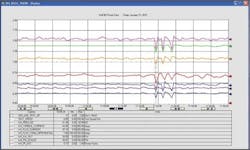Water resource management, from surface run-off regulations, to rainwater harvesting, is fast becoming an integral part of the commercial development process. Lutz Johnen, chairman of the UK's Rainwater Harvesting Association, looks at the latest trends and how the increasing trend for green roofs impacts on collecting rainwater.
Water is a precious resource and many experts are predicting periods of drought and flooding in the future, as the global population increases and climate change potentially causes localised, yet irrevocable changes in rainfall patterns.
The latest figures from the Environmental Agency (EA) show how water is under stress and as such there is likely to be further pressure put on developers to responsibly manage the resource.
Pressure to reduce water usage and produce more carbon neutral and environmentally sustainable buildings is clearly moving up the agenda. This is being driven from all sides, whether by a stricter government or local planning regulations. What is being done at ground level now has to reflect best practice and lead the way for other developers to follow suit.
Credit: Martine at Built Vision Photography
One flagship project was the Westfield shopping development in London. Initially contacted in 2005, Aquality was invited by the Waterman Group to look over the existing plans for rainwater harvesting. This was to be no simple task as the centre was required to handle 21 million visitors each year and supply more than 200 toilets across nine postcodes, all using harvested rainwater.
The Waterman Group originally proposed using separate rainwater harvesting and attenuation tanks to help control the water run off from the site. After consulting with Aquality it was decided that the most effective approach would be to combine the attenuation tanks with the rainwater storage system.
Such an approach allowed surface run off to be diverted from the sewer and feed the attenuation tanks, which in turn could feed water into the building to flush the toilets and feed urinals. The pump and control system was supplied in a way to make sure they were using the least amount of electricity as possible. The costs of the rainwater harvesting system were just £70,000, a relatively low figure set against the overall scale of the Westfield project.
Working with the environment
Whatever the project, the key to rainwater harvesting remains having the ability and flexibility to work with both the building, its location and structure as well as to take a holistic view of water management. Taking this view helps get the most out of the building as well as the opportunities and challenges presented by the environment.
Rainfall levels are an example of this. Although there's no denying that it rains often in the UK, there can be times of drought as we saw earlier in the year. For a large scale public building, there has to be a back-up system. This is because if rainwater runs low, it could mean closure of a facility of place of work if sanitation could not be maintained.
The issue has historically been overcome by having a mains water feed set directly to storage tanks. Doing this simply reduces the storage space for future rainwater, which in turn can dramatically reduce the cost-savings of having the rainwater harvesting in the first place.
A European method is to have the mains back up water fed directly to the pumps using an air gap to avoid cross-contamination. In short, this system means you only get mains water exactly when you need it - and the minimum amount of mains water to keep the system working smoothly. The perfect solution and one that considers likely rainwater levels and the building's ability to capture it.
Green roof challenges
More commercial developments are having to incorporate a range of green features – whether solar power, ground source heat pumps or a "green roof". The latter is now becoming the benchmark for many current large commercial re-developments and one which the rainwater harvesting industry must work closely with.
Of course, installing a roof garden, a `green insulation blanket' if you like, brings new challenges to rainwater harvesting. Having earth on the roof not only holds some of the rainfall, but alters the composition of the water which is being recycled. It calls for new filtration methods as well.
As demonstrated in Germany, there is now an option to provide systems which successfully clean the rainwater harvested from the covered earth sections of roofs. Or as in the case of Westfield, Waterman decided to cover just one fifth of the roof at Westfield with green earth, as there was a delicate balance between the insulation benefits of having a garden, and the substantial savings to be made from harvesting rainfall quickly and efficiently.
A more holistic approach
There's much talk of `holistic' approaches to building and development now and everyone in construction can see that legislation and regulation will drive this process. There's also another simple reason why `joined up thinking' is paramount today; it saves money. The Aquality rainwater harvesting system installed at Westfield is estimated to save around £612,000 over the 30-year lifespan of the building. This figure could increase as the calculations depend on rainfall.Consider the next case as a glimpse of life in the future. Severn Trent Water recently chose its Coventry HQ as a showcase project for efficient water use and to demonstrate best practice to its customers. The stated aim of the project was clear from the start; to be 100% self-sufficient with regards water usage.
The site needed to cater for the demands of more than 1,700 employees when the building is fully occupied next year. The new 170,000 sq ft building was also split over seven floors to add additional challenges to water distribution throughout the building.
The Aqua Control 5000 system was selected as it was able to combine and manage the various rainwater, greywater and borehole requirements that the site used. The system, which is the first of its kind to be used in the UK, is able to monitor water levels and distribute water at 7 Bar throughout the seven floor building.
The basement water storage tanks have the capacity to hold 12 cubic meters of water, split equally between three tanks allowing sufficient storage and resource for the building's needs. With the borehole only allowed to draw up to 20 cubic meters of water, a back up supply of mains water was also connected as a final supporting resource. This was incase the building would require an additional drinking water resource.
The system provides a viable solution for the buildings entire water needs. In addition all the building's appliances are specified for low water consumption, which has the added advantage of minimising waste water discharge to sewers for treatment.
Rainwater flow is mediated by a combination of harvesting for on-site use and an attenuation tank which reduces demand on the drainage systems, making best use of existing network capacity while minimising the risk of flooding.
You would expect water companies to provide the latest and best example of efficient water use. This latest project has set the precedent and is a great example of practising what you preach. Let's hope that other water companies and government departments insist that developers also aim for the same approach.
Author's note: Lutz Johnen is chairman of the UK's Rainwater Harvesting Association and managing director of Aquality Trading & Consulting.
More Water & WasteWater International Current Issue Articles
More Water & WasteWater International Archives Issue Articles





